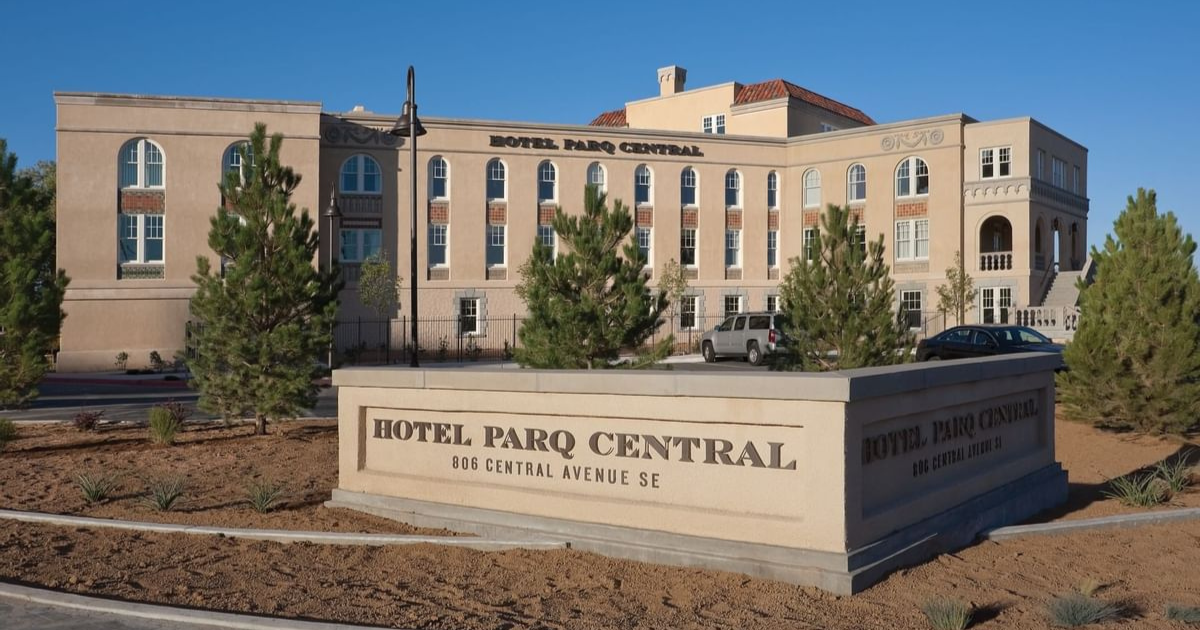Imagine a grand hotel standing tall, like a timeless guardian in the heart of Albuquerque. Welcome to Hotel Parq Central, a place where history whispers in every corner. Join us on a captivating journey through its intriguing past, where architectural wonders meet community spirit and extraordinary stories unfold. Prepare to be transported back in time, as we unveil the untold tales of this beloved landmark.
History of Hotel Parq Central Albuquerque
Hotel Parq Central, nestled in the heart of Albuquerque, boasts a captivating history dating back to 1926. Originally known as Sante Fe Hospital, the building served as a sanctuary for employees of the Atchison, Topeka & Santa Fe Railway.
Over the decades, the building underwent several transformations, each leaving its mark on its unique character. In the 1940s, it was renamed AT & SF Hospital, and by the 1980s, it became Memorial Hospital under the stewardship of a group of psychiatrists. Throughout these transitions, the walls bore witness to countless stories of hope, resilience, and the ever-changing face of healthcare.
By the 1990s, the building embarked on a new chapter, shedding its medical past and embracing a new identity as a boutique hotel. The transformation preserved the building’s Italianate architecture, its elegant façade a subtle nod to its storied past.
Hotel Parq Central’s time as a psychiatric hospital has fueled speculation and intrigue, leading to whispers of paranormal activity within its walls. Some believe that remnants of the building’s former life linger, manifesting as unexplained occurrences that continue to captivate and mystify visitors and staff alike.
Today, Hotel Parq Central celebrates its multifaceted history while offering guests a luxurious and unforgettable experience. The Apothecary Rooftop Lounge, a popular destination for locals and tourists, provides breathtaking panoramic views of the city and surrounding mountains.
Here’s a glimpse into the hotel’s captivating evolution:
| Feature | Description |
|---|---|
| Original Purpose | Built in 1926 as a hospital for railway workers. |
| Architectural Style | Italian-inspired, reflecting its historical use. |
| Transformations | From hospital to psychiatric institution, now a boutique hotel. |
| Reputation | Known for its paranormal activity and haunted tales. |
| Current Status | Historic landmark and a AAA Four Diamond Rating hotel. |
To delve deeper into the captivating history of Hotel Parq Central, visit the hotel’s website, where you’ll find a treasure trove of information and captivating anecdotes.
What is the history of the PARQ hotel in Albuquerque?
The PARQ Central Hotel, as it’s sometimes referred to, boasts a past far more intriguing than your average hotel. Established in 1926, the building first served as a bustling hospital for employees of the Atchison, Topeka & Santa Fe Railway. The Italian-inspired architecture, still evident today, reflects this era of dedicated service to the railroad industry.
However, the building’s story took an intriguing turn as it transitioned from a place of healing to a psychiatric institution, adding layers of mystery and speculation to its already fascinating past. Rumors of unusual occurrences and unexplained phenomena have circulated for years, leading some to believe that the hotel might harbor remnants of its past inhabitants.
Today, the PARQ Central Hotel seamlessly blends history and modern luxury. As a stylish boutique hotel, it offers guests a unique experience, inviting them to step back in time while enjoying contemporary amenities. The Apothecary Rooftop Lounge, renowned for its stunning city views, has become a popular gathering spot, drawing locals and visitors alike.
Here’s a quick look at the hotel’s captivating journey:
| Feature | Description |
|---|---|
| Original Purpose | Built in 1926 as a hospital for railway workers. |
| Architectural Style | Italian-inspired, reflecting its historical use. |
| Transformations | From hospital to psychiatric institution, now a boutique hotel. |
| Reputation | Known for its paranormal activity and haunted tales. |
| Current Status | Historic landmark and a AAA Four Diamond Rating hotel. |
For a deeper dive into the fascinating history of Hotel Parq Central, be sure to visit their website. You’ll uncover more captivating details and stories that bring this unique hotel’s past to life.
What is the history of the Memorial Hospital in Albuquerque?
While no longer in operation, Memorial Hospital, once a cornerstone of Albuquerque’s healthcare system, played a pivotal role in the city’s history. Established in 1926 as a dedicated facility for railroad workers, its establishment reflects the significance of the railroad industry in Albuquerque’s early development.
Over the years, Memorial Hospital expanded its services, adding a nursing school and clinic in the 1940s and 1960s, solidifying its role as a vital healthcare provider for the growing community. However, by 1982, financial constraints and declining patient numbers led to the hospital’s closure, marking the end of an era.
The building’s story didn’t end there. In 2002, the Youth and Family Centered Services of Austin recognized the building’s potential and embarked on a remarkable transformation, repurposing it into a haven for the city’s youth. Today, the former hospital stands as a testament to adaptability and the enduring power of community, offering essential services and support to Albuquerque’s younger generation.
What happened to the Alvarado hotel in Albuquerque?
The Alvarado Hotel, once a shining symbol of Albuquerque’s prosperity and a testament to the golden age of train travel, met a tragic end that continues to resonate with those who remember its grandeur. Constructed in an elaborate Mission Revival style, with its iconic bell towers reaching for the sky, the Alvarado Hotel stood as a beacon of elegance and sophistication.
However, the decline of train travel in the mid-20th century took a toll on the hotel’s fortunes. Despite efforts to revitalize the struggling establishment, financial difficulties mounted, leading to its closure in 1967.
The loss of such an architectural gem sparked a wave of nostalgia and regret. Despite attempts to garner support for its preservation, the Alvarado Hotel was demolished on February 2, 1970, making way for a parking lot, a stark reminder of progress’s sometimes irreversible toll on history.
The demolition served as a wake-up call for Albuquerque, igniting a movement to protect the city’s architectural heritage and preserve the stories embedded within its historic buildings. While the Alvarado Hotel is gone, its memory lives on, serving as a poignant reminder of the importance of cherishing and safeguarding our collective past.
How many floors is Hotel Albuquerque?
Albuquerque’s skyline boasts two prominent hotels, each reflecting a different facet of the city’s character. The Hyatt Regency Albuquerque, a towering 20-story skyscraper, stands as the second tallest building in the city, a symbol of modern ambition and progress.
In contrast, the Hotel Albuquerque at Old Town, a four-story structure nestled in the heart of the city’s historic district, exudes a more relaxed and traditional ambiance. Its architecture seamlessly blends with the surrounding historic buildings, offering a glimpse into Albuquerque’s past.
Here’s a side-by-side comparison of these two iconic hotels:
| Hotel | Number of Floors | Cool Facts |
|---|---|---|
| Hyatt Regency Albuquerque | 20 | Second tallest building in Albuquerque, the tallest hotel in Albuquerque. |
| Hotel Albuquerque at Old Town | 4 | Located in historic Old Town, blending in with the historic architecture of the area. |
The contrasting styles of these hotels symbolize Albuquerque’s ability to embrace both its rich history and its aspirations for the future.
When was PARQ casino built?
PARQ Vancouver, a relative newcomer to Vancouver’s entertainment scene, opened its doors on September 29, 2017, replacing the former Edgewater Casino. Situated adjacent to the iconic BC Place Stadium at 39 Smithe Street, the $700 million complex has quickly become a popular destination for locals and tourists alike.
The expansive casino floor, spanning 72,000 square feet, houses an impressive array of gaming options, including 600 slot machines and 75 table games. Catering to a diverse clientele, PARQ Vancouver also features two luxury hotels operated by Marriott—the JW Marriott and The Douglas—providing guests with upscale accommodations and convenient access to the casino’s offerings.
Beyond gaming, PARQ Vancouver has established itself as a premier event destination, boasting 13 ballrooms, boardrooms, and meeting rooms suitable for a wide range of gatherings, from lavish galas to intimate business meetings.
What was the area that would become Albuquerque originally called?
Before it was known as Albuquerque, the area held a name that painted a vivid picture of its natural landscape: Bosque Grande de San Francisco Xavier, meaning “The Great Woods of Saint Francis Xavier.” This designation speaks to the area’s abundant natural beauty and the role of the Spanish in shaping its identity.
The arrival of Spanish settlers in 1706 marked a turning point in the region’s history. Choosing to honor the Duke of Alburquerque, Francisco Fernández de la Cueva Enríquez, they established a villa, a small settlement that would eventually evolve into the city we know today. Over time, the name was shortened to Albuquerque, solidifying the Spanish influence on the region.
While the name change reflects a significant historical moment, it’s essential to remember that the history of Albuquerque extends far beyond its European roots. The area was inhabited by Pueblo peoples long before the arrival of the Spanish, and their legacy continues to enrich the city’s culture and heritage.
What is the history of the Scoot Inn?
The Scoot Inn, an Austin institution steeped in history and legend, has borne witness to the city’s transformation from a sleepy town to a bustling metropolis. Established in 1871, the building’s story begins as a humble grocery store, providing sustenance and respite to weary travelers arriving by train.
While historical records are incomplete, it’s believed that the Scoot Inn gradually transitioned from a purveyor of groceries to a popular gathering spot. As Austin grew, so did the Scoot Inn’s reputation as a casual beer joint, a place where locals could unwind, share stories, and forge connections.
As Austin’s music scene began to blossom, the Scoot Inn embraced its destiny as a live music venue, becoming an integral part of the city’s vibrant cultural tapestry. Some claim it to be the oldest continuously running music venue in Texas, a testament to its enduring appeal and historical significance.
Through changing ownership, countless performances, and evolving musical tastes, the Scoot Inn has remained true to its roots, offering a welcoming atmosphere where locals and newcomers alike can experience the heart and soul of Austin’s music scene.
What was the first building in Albuquerque?
Determining the absolute first building erected in Albuquerque proves challenging, as the city’s history stretches back centuries. Early inhabitants, likely residing in simple adobe structures crafted from readily available materials, left behind few traces of their dwellings.
However, we can identify some of the earliest buildings that played pivotal roles in shaping Albuquerque’s development. Anson Flats, constructed in 1910, stands as a testament to the city’s architectural evolution. This concrete structure, inspired by Eastern design principles, hinted at Albuquerque’s burgeoning modernity.
The First National Bank Building, completed in 1923, marked a significant milestone as Albuquerque’s first skyscraper. This towering structure symbolized progress and ambition, announcing the city’s arrival on a larger stage. Similarly, the Atchison, Topeka and Santa Fe Railway Memorial Hospital, built in 1926, reflected the vital role of the railroad industry in Albuquerque’s growth and prosperity.
It’s important to acknowledge that our understanding of history is constantly evolving. New discoveries and interpretations can reshape our knowledge of the past. While the precise identity of Albuquerque’s very first building may remain a mystery, we can appreciate the enduring legacy of those early structures that laid the foundation for the vibrant city we know today.
What is the history of the Albuquerque Museum?
The Albuquerque Museum, located in the heart of Old Town, has served as Albuquerque’s cultural cornerstone for over five decades. Established in 1967 as the Albuquerque Museum of Art, History, and Science, the museum has played a multifaceted role in preserving and showcasing the city’s rich heritage.
From its inception, the museum has demonstrated an unwavering commitment to supporting local artists, providing a platform for emerging and established talents to share their work with the community. This dedication to fostering creativity has contributed significantly to Albuquerque’s thriving arts scene.
Beyond its impressive collection of art, the Albuquerque Museum houses a vast repository of artifacts that offer a tangible link to the past. From ancient pottery crafted by the region’s original inhabitants to tools used by Spanish settlers and relics of the Wild West era, the museum’s collection provides a captivating journey through time.
The Albuquerque Museum recognizes the importance of community engagement and actively works to preserve Albuquerque’s cultural heritage. The museum collaborates with organizations dedicated to safeguarding historical landmarks and ensuring the continuity of traditions. Through educational programs and community outreach initiatives, the Albuquerque Museum strives to inspire an appreciation for the city’s unique history and cultural tapestry.
What is the History of Old Town Albuquerque?
Old Town Albuquerque, with its charming labyrinthine streets, vibrant plazas, and historic adobe buildings, offers a captivating glimpse into the city’s rich and layered past. While officially founded in 1706 by Spanish settlers, the area holds traces of human presence dating back centuries earlier.
Long before the arrival of Europeans, Pueblo peoples called this area home, their influence still palpable in the spirit and traditions that permeate Old Town. The Spanish recognized the strategic importance of the area, establishing a villa that quickly emerged as a hub for trade and cultural exchange. The arrival of American settlers and the advent of the railroad in the 19th century brought further growth and architectural diversity to Old Town, resulting in the eclectic mix of styles visible today.
Designated as a National Historic Landmark District, Old Town stands as a testament to Albuquerque’s ability to preserve its architectural heritage while embracing its dynamic present. Strolling through the narrow streets, visitors encounter art galleries, unique shops, and restaurants housed in centuries-old buildings, each with stories whispered through the passage of time.
While the year 1706 marks a pivotal moment in Old Town’s history, ongoing research suggests that the area’s story may extend even further back in time. New discoveries have the potential to reshape our understanding of Old Town’s origins and deepen our appreciation for this cultural treasure.










4 thoughts on “Unveiling the Past: A Historical Journey Through Albuquerque’s Hotel Parq Central”
Comments are closed.